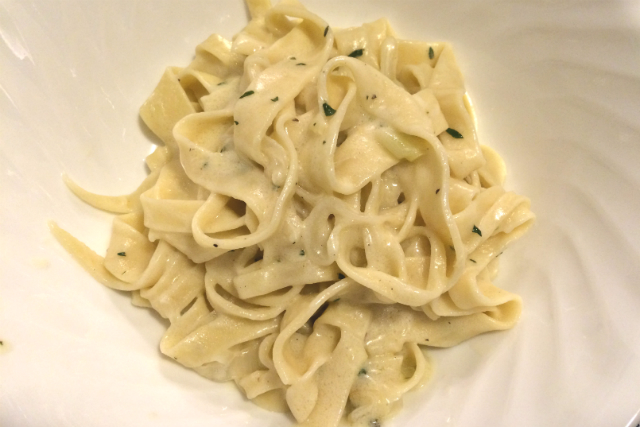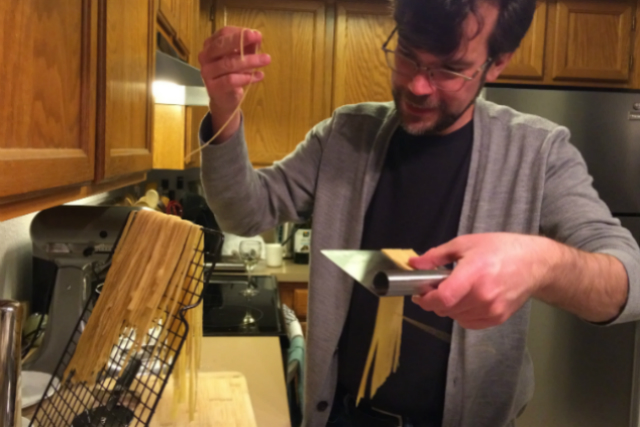Homemade Pasta Adventure
Who prepares homemade pasta one weekend because it sounds like fun? Someone who received a stand mixer pasta roller attachment as a lovely gift and needs success in the kitchen after weeks of meh experimental dishes and bread baking disasters.
Watching the questionable pasta dough hunk crawl up the hook and nearly jump out of the bowl started giving me second thoughts. Freaking dough. Again.
I had followed this pasta dough recipe, but didn’t spot the problems until after all the ingredients were in the bowl. It called for cups rather than specifying a weight for the flour, and made way too much. The dough also crumbled instead of turning into a ball so I added water a tablespoon at a time, finishing at five. Our eggs weren’t bad, but they weren’t particularly fresh, either.
With all that guesswork, the lasagnette came out better than expected, albeit a bit too thick. We ate it with leftover pastitio filling refreshed with red wine. The second day we took a quarter of the dough, rolled that thinner, and ate it with defrosted homemade pesto and freshly grated Parmesan. (The rest of the dough turned green in the fridge the next day. Yikes.)
Fast forward one week. Guillaume discovered a basic pasta dough recipe on Kitchen Aid’s Australian site that made about half the amount of dough, and specified a flour weight. He pored through the comments, did some research on other sites, went down a rabbit hole learning about flour types, and came up with the recipe below.
I sipped wine and watched him work in the cramped kitchen, meticulously cutting the pasta into narrower ribbons than mine. We prepared our trusty white wine sauce — honed from a WineFolly.com guide — with a little minced fresh thyme and oregano. Oh god that was good. Fresh pasta, when done right, is very much worth the effort.
Now you might be thinking, “Hey this all sounds great but I don’t have a pasta rolling machine. How do I make this?” Cooks Illustrated says it can be done with a rolling pin and elbow grease. Just make sure you get the dough quite thin.
Homemade Stand Mixer Rolling Machine Pasta
Makes approximately 1 lb. of fresh pasta dough
300 grams (10.5 oz.) unbleached all-purpose flour
Generous pinch salt
3 large very fresh eggs, lightly beaten
2 Tbsp. olive oil
1 or more Tbsp. water
Extra flour for dusting
Sift the flour into the stand mixer bowl. Add salt, eggs, and oil to the bowl. Attach the flat beater to the stand mixer, turn it to speed 2 until mixture is combined. Remove the flat beater and then attach the dough hook, kneading for 3 to 4 minutes on speed 1 or until the dough indents when touched. If it’s too dry, you can add water 1 tablespoon at a time, kneading briefly after each addition. Wrap the dough in plastic and allow to rest for 30 minutes in the fridge.
With lightly floured hands, knead the pasta dough for about 30 seconds and then cut into four pieces. If you’re making pasta for two, re-wrap and refrigerate the remaining half. Try to roll it out after dinner or as soon as you can since this dough won’t keep long.
Attach the flat pasta roller to the stand mixer. Set roller to 1, the widest setting. Take one quarter piece of dough and flatten it with your hands. Turn the stand mixer to speed 2 and feed the dough into the roller. Send it through a second time, sprinkling with a little flour first if it seems sticky.
Now increase the settings one notch at a time, running the dough through twice at each setting, until you reach 3. Cut the dough in half lengthwise and cut again horizontally to make four pieces. Continue at 4 and 5, running each piece through twice.
Lay the rolled dough pieces onto a lightly floured cutting board. Repeat the rolling process with another quarter of the original dough ball for two servings or roll it all for four servings.
Using a pizza cutter or sharp knife, cut each pasta piece into long ribbons as wide or as narrow as you like. Lay the cut pasta on a drying rack or a similar setup. You can cook it immediately or allow it to dry before freezing. King Arthur Flour has helpful tips on how to do that.
To cook, bring a large pot of well-salted water to a boil. Add a little olive oil to prevent sticking. Cook for about 4 minutes or until al dente. If finishing in a sauce, cook for less time.
Strain the pasta, reserving some of the water in case you need to loosen prepared sauce. Toss in sauce and serve.
Perfect White Wine Sauce
1 Tbsp. olive oil
1 shallot, minced or sliced finely
½ C. white wine
1 Tbsp. unsalted butter
1 Tbsp. flour
½ C. half-and-half
1 Tbsp. to ¼ C. fresh or dried herbs such as parsley or chives
Salt and fresh ground pepper to taste
Combine the half-and-half and flour in a small lidded glass jar and shake until the consistency is uniform. Set aside.
Heat a small saucepan on medium. Once it is hot, add the tablespoon of olive oil, followed by the shallot.
After the shallot is translucent, pour ½ cup white wine into the pan. This recipe also works with a similar amount of rosé, red wine or a spirit of your choice.
When the volume of the sauce has reduced by at least half, stir in a tablespoon of butter. If you are using fresh herbs in your sauce, add half of them now. For dry herbs, adding them near the end of the process allows you to adjust for taste. Their flavor will become stronger as the sauce sits.
Whisk in the half-and-half mixed with the flour. Stir over heat, lowering if needed, until thickened.
Season and correct. Start with ¼ tsp. of salt and a ¼ tsp. of pepper. Taste. It should be flavorful and have a slight kick. If you are using fresh herbs, mix in the other half, leaving a little for garnish if desired.
Buon appetito!



